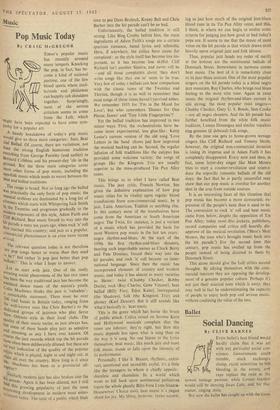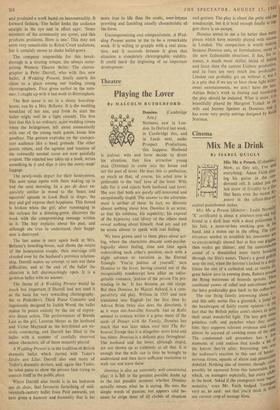Ballet
Social Dancing
By CLIVE BARNES EVEN ballet's best friend would hardly claim that it was art with any particular social con- science. Governments could tremble, stock exchanges slump, racial minorities be -left bleeding in the streets, and rape replace the twist as the newest teenage pastime, while Covent Garden would still be dancing Swan Lake, and, for that matter, singing Aida.
But now the ballet has caught up with the times and produced a work based on homosexuality. It forward fashion. The ballet looks the audience straight in the eye and in effect says: 'Some members of the community are queer, and this produces problems. Here is one.' This may not seem very remarkable to Royal Court audiences, but it certainly seems to shake ballet-goers.
The company responsible for this break- through is a touring troupe, the always enter- prising Western Theatre Ballet. The choreo- grapher is Peter Darrell, who with this new ballet, A Wedding Present, finally asserts his claim to a place among our leading young choreographers. First given earlier in the sum- mer, I caught up with it last week in Birmingham.
The first scene is set in a sleazy boarding- house, run by a Mrs. Bellamy. It is the wedding breakfast of her son, and from its start the ballet might well be a light comedy. The first hint that this is no ordinary, quiet wedding comes when the bridegroom, left alone momentarily with one of the young male guests, kisses him goodbye. The gesture explodes on the unexpec- tant audience like a hand grenade. The other guests return, and the agonies and tensions of the outwardly normal scene are now painfully evident. The rejected boy takes up a book, writes something in it and slips it into the newly-weds' luggage.
The newly-weds depart for their honeymoon. The next scene opens with them waking up in bed the next morning. In a pas de deux ex- quisitely similar in mood to the 'bears and squirrels' episode in Look Back in Anger, the boy and girl express their happiness. This thread is broken when the girl, after rummaging in the suitcase for a dressing-gown, discovers the book with the compromising message written in it. The boy explains about his past, and although she tries to understand, their happi- ness is destroyed.
The last scene is once again back at Mrs. Bellamy's boarding-house, and shows the return of the honeymoon couple, their marriage still clouded over by the husband's previous relation- ship. Darrell makes no attempt to sort out these difficulties, and at the end of the ballet the situation is left disconcertingly open. It is a problem ballet with no answer.
The theme of A Wedding Present would be much less important if Darrell had not used it as the basis for very rewarding choreography. Set to Prokofiev's Third Piano Concerto and ingeniously designed by Judith Wood, the ballet makes its points entirely by the use of expres- sive dance action. The performances of Brenda Last as the girl, Laverne Meyer as the husband and Victor Maynard as the boy-friend are en- tirely convincing, and Darrell has filled in the ballet with a number of carefully observed minor characters, all of them minutely played.
A Wedding Present is in the tradition of British dramatic ballet which started with Tudor's Jardin aux Lilas. Darrell also uses many of Tudors dramatic devices, and, again like Tudor, he takes pains to show the private face trying to contain itself in the public place.
Where Darrell also excels is in his bedroom pas de deux, that favourite furnishing of mid- twentieth-century ballet from Petit onwards, yet here given a humour and humanity that is far more true to life than the erotic, over-intense prowling and fumbling usually characteristic of the form.
Uncompromising and compassionate, A Wed- ding Present seems to me to be a remarkable work. It is willing to grapple with a real situa- tion, and it succeeds because it gives that situation a completely choreographic validity. It could mark the beginning of an important development.































 Previous page
Previous page